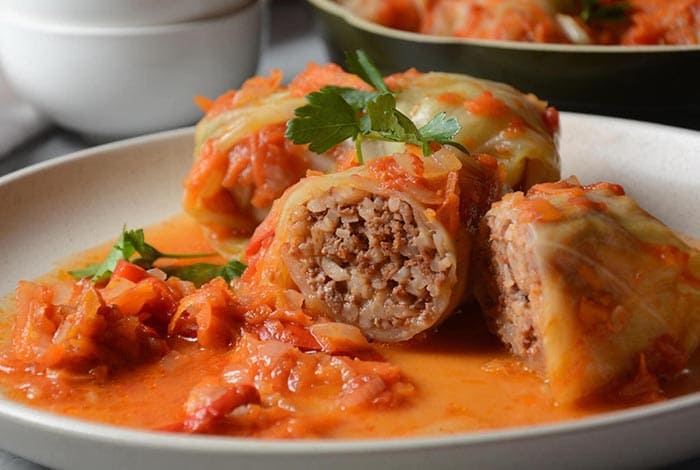Introduction to Stuffed Cabbage Rolls
Stuffed Cabbage Rolls, a dish rich in history and cultural significance, have been a cherished part of culinary traditions across the globe. Originating from the heart of Eastern Europe, this dish has traversed borders, adapting to local tastes and ingredients. Each region imparts its unique flair, making the recipe a tapestry of cultural influences. At its core, Stuffed Cabbage Rolls consist of tender cabbage leaves wrapped around a savory filling, typically a mix of meat and grains. This dish not only reflects the resourcefulness of traditional cooking—utilizing simple, available ingredients—but also symbolizes comfort and familial warmth. It’s a meal that tells stories of heritage and home, a testament to the enduring appeal of simple, hearty fare.
Ingredients and Variations
The traditional recipe for Stuffed Cabbage Rolls is straightforward yet allows for creativity. Common ingredients include:
- Cabbage leaves, usually from green cabbage for their pliability and mild flavor.
- A filling of ground meat, often beef or pork, mixed with cooked rice or barley.
- Seasonings like garlic, onion, salt, pepper, and sometimes herbs for added flavor.
However, this dish’s beauty lies in its adaptability to different cultural tastes and dietary needs. In Sweden, for instance, the rolls might include lingonberry jam for a sweet contrast, while in the Mediterranean, they are often cooked in a lemon-infused sauce for a tangy twist. Middle Eastern versions might incorporate spices like cinnamon and allspice.
For those with dietary restrictions, Stuffed Cabbage Rolls offer ample substitution options:
- Vegetarian and vegan versions can use lentils, mushrooms, or quinoa as filling.
- For a gluten-free alternative, rice or buckwheat can replace barley.
- Low-carb diets might favor cauliflower rice instead of traditional grains.
This versatility ensures that Stuffed Cabbage Rolls can be enjoyed by a wide range of palates and dietary preferences. The Kitchen Whisperer offers a great example of a classic recipe with potential variations.
Preparing the Cabbage Leaves
Preparing the cabbage leaves is a crucial step in making Stuffed Cabbage Rolls. The goal is to make the leaves pliable enough to roll without tearing. The most common technique involves gently boiling the whole cabbage head until the leaves soften. Some prefer the freezer method, where the cabbage is frozen and then thawed, which also softens the leaves. When choosing cabbage, opt for a fresh, green variety with large, unblemished leaves. The leaves should be intact and flexible. Carefully peeling them away from the head after softening ensures they remain whole, providing the perfect wrapper for your savory filling.
Dinner at the Zoo provides an excellent guide on how to prepare these leaves perfectly.
The Filling
The heart of Stuffed Cabbage Rolls lies in its filling, traditionally a hearty blend of meat and rice. Ground beef or pork, sometimes mixed, is combined with cooked rice, offering a rich and satisfying texture. For seasoning, common choices include minced garlic, diced onions, salt, pepper, and herbs like parsley or dill for freshness.
For a vegetarian twist, lentils, chopped mushrooms, or a mix of grains like quinoa and bulgur can replace the meat. These alternatives not only cater to different dietary preferences but also add unique flavors and textures. When flavoring vegetarian fillings, consider adding smoked paprika or cumin for a depth of flavor akin to the meat-based version. Regardless of the filling choice, balancing the seasoning is key to ensuring a flavorful result.
Rolling and Cooking Techniques
Rolling Stuffed Cabbage Rolls requires a bit of technique but is straightforward:
- Lay a softened cabbage leaf flat.
- Place a portion of the filling at the leaf’s base.
- Fold in the sides and roll the leaf up tightly, enclosing the filling.
For cooking, there are several methods:
- Baking: Place the rolls in a baking dish, cover with sauce, and bake until tender. This method often yields a slightly crispy exterior.
- Boiling: Simmer the rolls in a pot of broth or sauce. This traditional method ensures the rolls are moist and tender.
- Slow Cooking: For a hands-off approach, layer the rolls in a slow cooker with sauce and cook on low heat. This method allows flavors to meld beautifully.
To ensure even cooking, arrange the rolls in a single layer and regularly check for doneness, especially if baking or boiling.
Serving and Presentation
Stuffed Cabbage Rolls are traditionally served with simple, hearty sides. Mashed potatoes, steamed vegetables, or a light salad complement the rich flavors of the rolls. In some cultures, a dollop of sour cream or a sprinkle of fresh herbs like dill or parsley is added on top for extra flavor.
For presentation, arrange the rolls neatly on a platter, garnish with fresh herbs, and drizzle with a bit of the cooking sauce. Serving them in a dish where they were cooked can also add a rustic charm. Remember, the key to an appealing presentation is simplicity and highlighting the rolls themselves.
Storage and Reheating
Stuffed Cabbage Rolls store exceptionally well, making them perfect for leftovers. For refrigeration, place them in an airtight container; they’ll keep for up to 4 days. When freezing, wrap each roll individually in plastic wrap and then place them in a freezer-safe bag or container. They can be frozen for up to 3 months. For reheating, thaw overnight in the refrigerator if frozen. Then, warm them in the oven at 350°F until heated through, which preserves their texture better than microwaving. Adding a splash of water or sauce before reheating can help keep them moist.
FAQs
Q: Can I make Stuffed Cabbage Rolls ahead of time? A: Absolutely! Prepare them up to the point of cooking, then refrigerate or freeze until you’re ready to cook.
Q: What’s the best way to soften cabbage leaves? A: Boiling the whole head briefly until the leaves peel off easily is the most common method. Some prefer freezing the cabbage first, which also softens the leaves.
Q: Can Stuffed Cabbage Rolls be made vegetarian? A: Yes, replace the meat with a mixture of grains like rice or quinoa, lentils, and finely chopped vegetables.
Q: How do I prevent the rolls from falling apart while cooking? A: Ensure the leaves are properly softened and don’t overfill them. Secure the rolls tightly before cooking.
Q: Are there any gluten-free options for Stuffed Cabbage Rolls? A: Yes, you can use gluten-free grains like quinoa or buckwheat instead of traditional rice.
Conclusion
In conclusion, Stuffed Cabbage Rolls are a versatile and comforting dish, steeped in tradition yet open to adaptation. Whether you stick to the classic meat and rice combination or explore vegetarian or gluten-free variations, they’re sure to be a satisfying meal. Remember, the key to perfect rolls lies in the preparation of the cabbage leaves and the balance of flavors in the filling. With options for make-ahead preparation and easy storage, they’re not just delicious but also convenient for busy schedules. Embrace the simplicity and heartiness of this classic dish and enjoy a taste of culinary tradition.

Stuffed Cabbage Rolls Recipe
Equipment
- Large pot for boiling cabbage
- Mixing bowl
- Baking dish
- Aluminum foil
- Knife and cutting board
Ingredients
For the Cabbage and Filling:
- 1 large head of green cabbage
- 1 lb ground beef
- 1/2 cup cooked white rice
- 1 medium onion finely chopped
- 2 cloves garlic minced
- 1 egg
- 1 teaspoon salt
- 1/2 teaspoon black pepper
- 1/2 teaspoon paprika optional
For the Sauce:
- 1 can 14 oz crushed tomatoes
- 2 tablespoons tomato paste
- 1 tablespoon brown sugar
- 2 tablespoons lemon juice
- 1 teaspoon Worcestershire sauce
- Salt and pepper to taste
Instructions
Preparing the Cabbage:
- Core the Cabbage: Remove the core from the cabbage.
- Boil the Cabbage: In a large pot, boil water and submerge the cabbage head. Boil for about 2-3 minutes, then peel off the softened leaves. Repeat until you have enough leaves (about 12-15).
Making the Filling:
- Combine Ingredients: In a bowl, mix together the ground beef, cooked rice, onion, garlic, egg, salt, pepper, and paprika until well combined.
Preparing the Sauce:
- Mix Sauce Ingredients: In a separate bowl, combine crushed tomatoes, tomato paste, brown sugar, lemon juice, Worcestershire sauce, and season with salt and pepper.
Assembling the Rolls:
- Trim the Cabbage Leaves: Trim the thick vein from the bottom of each cabbage leaf, making it easier to roll.
- Add Filling: Place about 2 tablespoons of the meat mixture in the center of each cabbage leaf.
- Roll the Leaves: Fold in the sides and roll the leaf up tightly, enclosing the filling.
Cooking:
- Preheat Oven: Preheat your oven to 350°F (175°C).
- Layer the Rolls and Sauce: In a baking dish, spread a thin layer of the sauce. Place the cabbage rolls seam side down in the dish. Pour the remaining sauce over the rolls.
- Bake: Cover the dish with aluminum foil and bake for about 1 hour or until the meat is cooked through and the cabbage is tender.
Serving:
- Serve the Stuffed Cabbage Rolls hot, with extra sauce spooned over the top. They pair well with mashed potatoes or a simple salad.
Notes
- Vegetarian Option: Substitute ground beef with a mix of lentils and mushrooms for a vegetarian version.
- Make-Ahead: These rolls can be prepared a day in advance and baked when needed.
- Freezing: Freeze the rolls before baking for a quick future meal. Thaw overnight in the refrigerator before baking.

